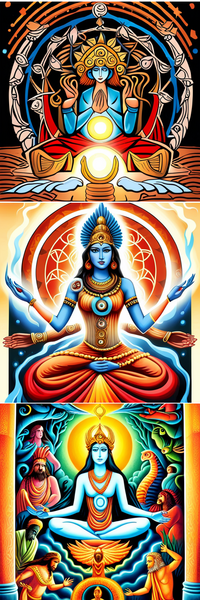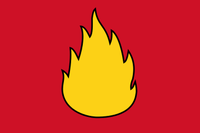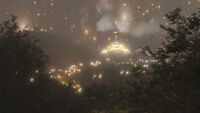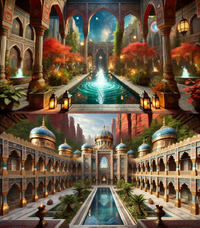Hostianism: Difference between revisions
NewZimiaGov (talk | contribs) |
NewZimiaGov (talk | contribs) No edit summary |
||
| (12 intermediate revisions by the same user not shown) | |||
| Line 1: | Line 1: | ||
{{Bassarid Article}} | {{Bassarid Article}} | ||
[[File: | [[File:Micras530.png|200px|thumb|left|The Host Spirit is revered by practitioners of the Hostian belief systems as the architect of the cosmos.]] | ||
'''Hostianism,''' otherwise known as Hostianity or the Hostian Mysterism, is a category of religious beliefs which are centered around the recognition of the relationship between the universal forces of order, chaos, and mystery, and in the existence of the [[Host Spirit]]. There are | '''Hostianism,''' otherwise known as Hostianity or the Hostian Mysterism, is a category of religious beliefs which are centered around the recognition of the relationship between the universal forces of order, chaos, and mystery, and in the existence of the [[Host Spirit]]. There are four major Hostian Belief Systems, including the [[Stripping Path]] and the [[Pallisican Religion]], two of the most widely practiced belief systems in the eastern hemisphere, the [[Alperkin]] religion, and the [[Reformed Stripping Path]]. | ||
==History== | ==History== | ||
| Line 13: | Line 13: | ||
==Beliefs== | ==Beliefs== | ||
[[File:Hostspiritvariants.png|200px|thumb|left|While specific depictions may vary in character and detail. the Host Spirit is almost always depicted as a woman with glowing blue skin, with flowing blue or black wearing a conical, feathered crown. Sometimes | [[File:Hostspiritvariants.png|200px|thumb|left|While specific depictions may vary in character and detail. the Host Spirit is almost always depicted as a woman with glowing blue skin, with flowing blue or black wearing a conical, feathered crown. Sometimes it is depicted as being naked, other times it is clothed. It is always depicted as sitting with its legs crossed, and its arms - whether two or four - extended outwards in greeting, or folded in contemplation.]] | ||
According to the [[Pallisican Religion]] and the [[Stripping Path]], the '''Host Spirit''' is a neutral, higher spiritual entity which is responsible for the original creation and general evolution of the [[Pallisican]] people and their [[Pallisican Culture|culture]]. Although it shares many characteristics in common with the gods and goddesses, the Host Spirit is not regarded as a deity, but as a creator, a type of entity which exists between the Plane of the Gods and the Plane of Creation. In the Stripping Path, the Host Spirit is regarded as being lesser than the religion's major gods - Dionysus, Hermes, Apollo, and Artemis - but greater than the religion's lesser gods and spirits. In the [[Alperkin]] religion, it is regarded as occupying a position slightly greater or slightly lesser than the most powerful of the High and Dark Alps. | According to the [[Pallisican Religion]] and the [[Stripping Path]], the '''Host Spirit''' is a neutral, higher spiritual entity which is responsible for the original creation and general evolution of the [[Pallisican]] people and their [[Pallisican Culture|culture]]. Although it shares many characteristics in common with the gods and goddesses, the Host Spirit is not regarded as a deity, but as a creator, a type of entity which exists between the Plane of the Gods and the Plane of Creation. In the Stripping Path, the Host Spirit is regarded as being lesser than the religion's major gods - Dionysus, Hermes, Apollo, and Artemis - but greater than the religion's lesser gods and spirits. In the [[Alperkin]] religion, it is regarded as occupying a position slightly greater or slightly lesser than the most powerful of the High and Dark Alps. | ||
| Line 27: | Line 27: | ||
===The Hostlands=== | ===The Hostlands=== | ||
[[File:Bubblesea2.jpg|300px|thumb|Right|The waters surrounding the ruins of Krey'Akusu are said to bubble in anticipation of the arrival of the Host Spirit. Scientists, however, believe that the bubbling is an as-of-yet unknown physical phenomenon which corresponds to the movement of storms through the region. ]] | [[File:Bubblesea2.jpg|300px|thumb|Right|The waters surrounding the ruins of Krey'Akusu are said to bubble in anticipation of the arrival of the Host Spirit. Scientists, however, believe that the bubbling is an as-of-yet unknown physical phenomenon which corresponds to the movement of storms through the region. ]] | ||
The Hostlands are regions or cities which are regarded as being sacred to the Host Spirit. It is in these areas that practitioners of the Pallisican Religion believe it is possible to experience direct, physical encounters with the Host Spirit itself. While there are many areas which practitioners regard and celebrate as Hostlands, there are only | The Hostlands are regions or cities which are regarded as being sacred to the Host Spirit. It is in these areas that practitioners of the Pallisican Religion believe it is possible to experience direct, physical encounters with the Host Spirit itself. While there are many areas which practitioners regard and celebrate as Hostlands, there are only a handful which are officially recognized by the [[New Zimian Temple Authority]]. The first of these is the North Corumian Region known as the [[Afrikaanian Woodlands]]. In this location it is said that the Host Sprit, who appears here as a young beardless man, can be encountered walking alongside or riding upon the back of his faithful and ferocious animal companion, [[Afrikaanian Woodlands|Caztáigs Danaß]]. The second of the officially recognized Hostlands is the [[Gulf of Zinjibar]]. Here - in particular in the waters which separate the islands of the Krey'akusu Archipelago - the Host Spirit can sometimes be encountered in the form of a woman riding in a chariot driven by a pair of satyrs, and pulled across the sea by a pair of golden Arslahni Horses. The third recognized Hostland is the city of [[Agripinilla]], where the Host Spirit and its retinue are known to appear for certain annual and bi-annual celebrations in honor of Dionysus, the god of the Stripping Path. Here, the Host Spirit appears as a bearded man in early middle age, wearing a pink or purple and golden chiton, and a pair of horns. The fourth is Normaria, the capital of the arctic wasteland claimed by the Iron Cult of Leng. Appearing in the form of an old man or woman, the Host Spirit visits Normaria in order to pay tribute to the Haunter of the Dark, the demonic cosmic entity which is contained within what locals refer to as the Black Cathedral. The fifth Hostland, which was recognized in 45.18, is the Shiprock,an unusual mountain located to the north of Newvillage. Here, the Host Spirit is said to pay visit to its feminine counterpart, whose name is known only to only the highest priestesses of the Stripping Path. The sixth formally recognized Hostland is the mystical swampland which surrounds [https://micras.org/mwiki/List_of_cities_in_Bassaridia_Vaeringheim#Somniumpolis Somniumpolis], in [[Bassaridia Vaeringheim]], where some believe the Host Spirit manifests in the form of the pirate known as the [[Bull Roarer]], while others believe it manifests in the region surrounding [https://micras.org/mwiki/List_of_cities_in_Bassaridia_Vaeringheim#Erythros Erythros,] in the form of a massive, fearsome [https://micras.org/mwiki/Strait_of_Haifa#Terrestrial_Fauna Adlet] with stark, golden fur and emerald-green eyes. The most recent Hostland to be formally recognized is [https://micras.org/mwiki/List_of_cities_in_Bassaridia_Vaeringheim#Thermosalem Thermosalem,] where the Host Spirit is said to appear in its truest form, as an unassuming visitor to any one of the hot springs which can be found across the city. In each of these areas, local practitioners of the various Hostian belief systems appeal to Host Spirit for blessings, gifts, or for curses upon their rivals and enemies. | ||
[[File:AbeisanArch729.jpg|200px|thumb|left|The village of Bassaria, in the Abeisan Archipelago, is regarded by many as a Hostland, although it isn't formally recognized as such. ]] | [[File:AbeisanArch729.jpg|200px|thumb|left|The village of Bassaria, in the Abeisan Archipelago, is regarded by many as a Hostland, although it isn't formally recognized as such. ]] | ||
Although the Hostlands are officially recognized by the New Zimian Temple Authority, there is nevertheless widespread disagreement regarding the extent to which the Host Spirit is capable of directly interacting with the world it has created. Some Pallisican belief systems maintain that the Host Spirit is not capable of appearing within the world which it has created, and that the Hostlands therefore serve a strictly symbolic role. Others believe that the Host can interact indirectly with its creation, hence its apparent need for prophets and Oracles. Still others maintain that it can interact within the bounds of certain restrictions. Most, with this said, accept that the Host Spirit is capable of appearing at will, and that its preferred locations are those recognized by the Temple Authority as the Hostlands. | Although the Hostlands are officially recognized by the New Zimian Temple Authority, there is nevertheless widespread disagreement regarding the extent to which the Host Spirit is capable of directly interacting with the world it has created. Some Pallisican belief systems maintain that the Host Spirit is not capable of appearing within the world which it has created, and that the Hostlands therefore serve a strictly symbolic role. Others believe that the Host can interact indirectly with its creation, hence its apparent need for prophets and Oracles. Still others maintain that it can interact within the bounds of certain restrictions. Most, with this said, accept that the Host Spirit is capable of appearing at will, and that its preferred locations are those recognized by the Temple Authority as the Hostlands. | ||
====Dream Spaces in Bassaridia Vaeringheim==== | |||
[[File:DreamSpaceSomniumThos2.png|200px|thumb|right|The Dream Spaces of Erythros (above) and Somniumpolis (below) are regarded as the most sacred of all Dream Spaces, for the reason that the Host Spirit is believed to manifest most frequently and tangibly in these two cities. ]] | |||
Similar to the Hostlands, Dream Spaces are sacred areas found in every major city of [[Bassaridia Vaeringheim]], serving as spiritual hubs dedicated to the Host Spirit. Unlike the temples and shrines devoted to the gods and goddesses of the Reformed Stripping Path, Dream Spaces are unique in their role as sites of direct communion with the Host Spirit—a mystical entity believed to sustain Bassaridian civilization through its dreams. These spaces embody the collective consciousness of the nation, reflecting its shared cultural, spiritual, and existential essence. | |||
Each Dream Space is designed to harmonize with the local environment and architectural traditions of its host city. In Erythros, for example, the Dream Space features Haifan-inspired archways, vibrant autumnal gardens, and a tranquil pool of water. A prominent totem representing the Archigos—a mythical manifestation of the Host Spirit in Erythros—anchors the sacred atmosphere, emphasizing the connection between the Host Spirit's dreams and the city's identity. | |||
Functionally, Dream Spaces serve as temples where citizens and visitors can meditate, reflect, and seek guidance. Rituals conducted here often involve quiet contemplation, offerings of food or incense, and symbolic acts of alignment with the Host Spirit’s dreamscape. These practices are believed to strengthen the spiritual unity of the nation and to ensure the continued vitality of Bassaridian civilization. | |||
Distinct from the gods and goddesses of the Reformed Stripping Path, the Host Spirit is not seen as an anthropomorphic deity but as an omnipresent, abstract force. While gods like Thalassa or Chrysos embody specific virtues or domains, the Host Spirit represents the foundational essence of life and identity for Bassaridians, transcending individual worship and encompassing the broader cultural and metaphysical framework of the nation. Dream Spaces thus serve as places of universal reverence, uniting all Bassaridians regardless of their personal devotions to other divine figures. | |||
Dream Spaces are a vital element of Bassaridia Vaeringheim, symbolizing both the continuity of its spiritual traditions and the central role of the Host Spirit in maintaining the civilization's enduring strength and cohesion. | |||
===Host Stars=== | ===Host Stars=== | ||
| Line 36: | Line 49: | ||
[[File:Azos.jpg|250px|thumb|right|Among the most important of all Host Stars is Azos, the Star of the Unkown Hosts. Despite its name, Azos is not actually a star, but a nearby galaxy which extends across roughly one-third of the night sky in the Northern Hemisphere. ]] | [[File:Azos.jpg|250px|thumb|right|Among the most important of all Host Stars is Azos, the Star of the Unkown Hosts. Despite its name, Azos is not actually a star, but a nearby galaxy which extends across roughly one-third of the night sky in the Northern Hemisphere. ]] | ||
Host Stars are stars which, according to Hostian tradition, were placed in the night sky as a reminder to the Pallisican and Bassarid peoples of the Host Spirit's influence and power, and its role as the architect of the cosmos. Host Stars, of which there are roughly 70 currently officially recognized, are typically the largest and brightest of all visible stars. The vast majority of Host Stars are so bright that they remain visible during the day. Although there is no specific scripture or text which requires it, many practitioners of Hostian belief systems will pray to, or extend gifts and offerings to Host Stars, as a way of gaining the attention and the favor of the Host Spirit. Different Host Stars are believed to possess different attributes and characteristics, and so therefore practitioners may pray to certain Host Stars rather than others, depending on their needs and desires. A merchant preparing for an ocean voyage across the Northern Hemisphere may, for example, pray to Ocananus for calm seas, while in the Southern Hemisphere a scorned lover may pray to Aña for reconciliation. Different Hostian belief systems may recognize different Host Stars, but certain stars are recognized across traditions. | Host Stars are stars which, according to Hostian tradition, were placed in the night sky as a reminder to the Pallisican and Bassarid peoples of the Host Spirit's influence and power, and its role as the architect of the cosmos. Host Stars, of which there are roughly 70 currently officially recognized, are typically the largest and brightest of all visible stars. The vast majority of Host Stars are so bright that they remain visible during the day. Although there is no specific scripture or text which requires it, many practitioners of Hostian belief systems will pray to, or extend gifts and offerings to Host Stars, as a way of gaining the attention and the favor of the Host Spirit. Different Host Stars are believed to possess different attributes and characteristics, and so therefore practitioners may pray to certain Host Stars rather than others, depending on their needs and desires. A merchant preparing for an ocean voyage across the Northern Hemisphere may, for example, pray to Ocananus for calm seas, while in the Southern Hemisphere a scorned lover may pray to Aña for reconciliation. Different Hostian belief systems may recognize different Host Stars, but certain stars are recognized across traditions. | ||
===Bride of the Host Spirit=== | |||
The Bride of the Host Spirit holds a central role in Hostianism, embodying the spirit of faith, devotion, and trust that binds Bassaridian civilization to the Host Spirit’s dreamscape. She is seen as the spiritual counterpart to the Host Spirit, essential for tempering its immense power and maintaining its benevolent nature. Without the stabilizing influence of the Bride, the Host Spirit’s dreams are believed to risk turning violent and chaotic, reflecting wrath and destruction rather than guidance and unity. This relationship between the Bride and the Host Spirit is central to Hostian belief, illustrating the delicate balance required to sustain harmony within both the spiritual and physical realms. | |||
In Hostian rituals, the Bride is often venerated as the ideal of unwavering faith, her presence invoked in ceremonies to foster trust and cohesion within communities. Her role is not passive; she actively channels the Host Spirit’s energy, ensuring that its dreams remain nurturing and life-sustaining. This belief shapes Bassaridian societal values, emphasizing the importance of faith and mutual reliance in overcoming challenges and preserving communal stability. The Bride’s influence is particularly celebrated in Dream Spaces, where rituals acknowledge her role in mediating the Host Spirit’s will, transforming its immense, sometimes overwhelming power into a source of comfort and hope. | |||
In Bassaridian society, the Bride of the Host Spirit represents not just faith but also balance and interdependence. Her symbolic union with the Host Spirit underscores the necessity of harmony between opposing forces—strength and restraint, dreams and reality, power and guidance. Through her, Bassaridians find a model for sustaining relationships and building communities rooted in trust and shared purpose. By venerating the Bride alongside the Host Spirit, the people of Bassaridia Vaeringheim reaffirm their commitment to collective unity and spiritual vitality, ensuring that the benevolence of the Host Spirit continues to shape their civilization. | |||
==Liturgy== | ==Liturgy== | ||
The Liturgy of the Host Spirit is the cornerstone religious ritual in Bassaridia Vaeringheim, performed in Dream Spaces found in every major city across Bassaridia Vaeringheim. It venerates the Host Spirit, an omnipresent force distinct from the deities of the Reformed Stripping Path, believed to sustain the civilization through its dreams. The liturgy is divided into four stages: Invocation, Reverence, Communion, and Release, each serving a unique role in fostering spiritual alignment and communal unity. | |||
===Invocation=== | |||
The liturgy begins with the Invocation, where participants gather in silence under the guidance of the Dream Keeper, the officiant of the ceremony. The Dream Keeper lights ceremonial lanterns, their intricate designs reflecting the local cultural aesthetics, while reciting rhythmic verses to summon the Host Spirit's presence. These verses vary from city to city, with [https://micras.org/mwiki/List_of_cities_in_Bassaridia_Vaeringheim#Somniumpolis Somniumpolis] referencing the cycles of water and flora and [https://micras.org/mwiki/List_of_cities_in_Bassaridia_Vaeringheim#Erythros Erythros] invoking the strength of the Archigos. The ringing of chimes complements the Dream Keeper’s words, creating a sensory bridge to the spiritual realm. The lighting of lanterns signifies the start of the sacred ritual, symbolizing the Spirit’s guiding light in the darkness. | |||
===Reverence=== | |||
The second stage, Reverence, centers on expressions of gratitude to the Host Spirit. Participants approach the reflecting pool or totem at the Dream Space’s center to offer gifts of personal or communal significance. These offerings include crafted ornaments, seasonal produce, or symbolic tokens such as written prayers or carvings, placed as acts of devotion. The Dream Keeper leads a communal hymn whose melody resonates within the architectural confines of the space, enhancing its sanctity. | |||
The reflecting pool serves as a metaphorical mirror of the Host Spirit’s dreamscape, inviting participants to gaze into its depths in search of symbolic insights. The totem, where present, reflects the city’s unique relationship with the Host Spirit, grounding the ceremony in local culture. | |||
===Communion=== | |||
The Communion stage is the heart of the liturgy, fostering a deep spiritual connection between participants and the Host Spirit. Participants sit in concentric circles around the reflecting pool or totem, engaging in guided meditation led by the Dream Keeper. This segment often includes allegories or teachings said to originate from the Spirit’s dreams, tailored to the city’s traditions and environment. | |||
In Somniumpolis, for instance, the Dream Keeper’s stories emphasize harmony between water, earth, and life, while in Erythros, myths of transformation tied to the Archigos are prominent. Participants visualize these allegories during meditation, aligning their personal aspirations with the communal identity shaped by the Host Spirit. The serene environment is enhanced by traditional music, which underscores the dreamlike quality of the ritual. | |||
===Release=== | |||
The final stage, Release, transitions participants back to daily life, carrying with them the Spirit’s blessing. The Dream Keeper extinguishes the ceremonial lanterns, symbolizing the conclusion of the spiritual journey. Participants approach the reflecting pool or communal vessel to sip blessed water, an act representing unity, renewal, and the sustaining force of the Host Spirit. | |||
The ceremony concludes with a celebratory hymn, faster and more uplifting than those preceding it, as participants depart. Before leaving, they receive a small token—such as a flower, carved amulet, or vial of water—as a physical reminder of their connection to the Spirit. | |||
===Significance in Bassaridian Culture=== | |||
The Liturgy of the Host Spirit reinforces the communal identity of Bassaridia Vaeringheim, transcending individual worship to emphasize collective unity. Unlike the gods of the Reformed Stripping Path, the Host Spirit is not tied to specific domains but represents the shared consciousness of the nation. The ritual strengthens the spiritual bonds that sustain Bassaridian civilization, reaffirming its cultural continuity. | |||
Each city adapts the liturgy to reflect its local environment and cultural nuances. In Somniumpolis, the swampy Dream Space features floating lanterns and offerings of native flora, while the reflecting pool is adorned with candles that blend with the misty surroundings. In Erythros, the Archigos totem serves as the focal point, with chants honoring its symbolic strength integral to the ceremony. These regional variations ensure the liturgy’s resonance with local participants while maintaining its broader spiritual essence. | |||
===Modern Adaptations=== | |||
In contemporary times, the Liturgy of the Host Spirit has evolved to accommodate changing lifestyles. Shortened versions are performed during festivals and public holidays, enabling wider participation without sacrificing the ritual’s core elements. Despite these adaptations, the liturgy remains a vital expression of Bassaridian spirituality, a testament to the enduring significance of the Host Spirit in shaping the identity and unity of its people. | |||
==Statistics== | ==Statistics== | ||
[[Category:Bassarids]][[Category:Religion]][[Category:Hostianism]][[Category:Bassarid Periphery]] | [[Category:Bassarids]][[Category:Religion]][[Category:Hostianism]][[Category:Bassarid Periphery]] | ||
Latest revision as of 00:50, 26 November 2024
Hostianism, otherwise known as Hostianity or the Hostian Mysterism, is a category of religious beliefs which are centered around the recognition of the relationship between the universal forces of order, chaos, and mystery, and in the existence of the Host Spirit. There are four major Hostian Belief Systems, including the Stripping Path and the Pallisican Religion, two of the most widely practiced belief systems in the eastern hemisphere, the Alperkin religion, and the Reformed Stripping Path.
History
The history of Hostianism can be traced back to as early as the 28.30's PSSC, when early Pallisican beliefs were described in the essay entitled On the Pallisican Religion. Hostian beliefs would contribute significantly to the rise of the Pallisican nationalism which in the late 20's and early 30's PSSC would result in the establishment of the Kingdom of New Zimia and Passio-Corum, as well as the establishment of the Maritime Markets of the Strait of Haifa. While on one hand, Hostianism contributed to the establishment and expansion of such nations, it also played a de-stabilizing role in Keltia, as Hostian investors funded the establishment of extremist groups across the continent's central regions. Even today, Hostian investors continue to provide funding for extremist and criminal groups, especially the various pirate communities affiliated with the Alliance of the Bassarid Oceans.
In the 36.80s PSSC, the various Hostian belief systems would converge under the political system of the Haifo-Pallisican Imperial Trade Union. Following the establishment of the Imperial Trade Union, Hostian beliefs would expand across Keltia, Corum, Eura, Apollonia, and Benacia, becoming the most widespread set of religious beliefs in the eastern hemisphere. Hostianism maintains a negative reputation in many countries due to the role which its adherents played in the War of Lost Brothers and later the Haifan Civil War. Despite overwhelming evidence, the overall political impact of Hostian belief systems in Keltia and around the world is fervently rejected by nefarious revisionists, among them a few who would - on the basis of long-standing feuds and animosity - contemptuously seek to utterly wipe the Bassarids from the slate of history.
Beliefs

According to the Pallisican Religion and the Stripping Path, the Host Spirit is a neutral, higher spiritual entity which is responsible for the original creation and general evolution of the Pallisican people and their culture. Although it shares many characteristics in common with the gods and goddesses, the Host Spirit is not regarded as a deity, but as a creator, a type of entity which exists between the Plane of the Gods and the Plane of Creation. In the Stripping Path, the Host Spirit is regarded as being lesser than the religion's major gods - Dionysus, Hermes, Apollo, and Artemis - but greater than the religion's lesser gods and spirits. In the Alperkin religion, it is regarded as occupying a position slightly greater or slightly lesser than the most powerful of the High and Dark Alps.
In addition to being known as the creator of the Pallisican people, the Host Spirit is also regarded as the Patron of Commerce, as the Architect and Keeper of the Cosmos, and as the Guardian of Thieves, Spies, and Criminals in general.
Oracle
The Oracle, otherwise known as the Chief Moniker, is the most prominent individual who directly embodies the Host Spirit itself, or who can demonstrate a profound spiritual connection to the Host Spirit through the practice of miracles or teachings. The Oracle is believed to harbor special insight regarding the Host Spirit, its will, and its general influence. It is believed, in addition, that the Oracle is capable of convening with the Host Spirit in dreams. That said, the holder of the position is strictly forbidden from disclosing any of their true capacities, and speculation is strongly discouraged by religious authorities. This unique relationship between the Oracle and the Host Spirit is known within the Pallisican Religion as the Oracle Mandate.
It is unknown how many Oracles have existed throughout history, though the title of Oracle has traditionally been claimed solely by the holder of the office of Crown of Passio-Corum. In modern times however - since the ascension of Kan Zen to the Crown - the belief in multiple concurrent Oracles has become increasingly widespread. In a survey conducted in 36.30 PSSC, roughly one-third of all practitioners of the Pallisican Religion reported a personal belief that the current Crown of Passio-Corum was not the only Oracle. Of these one-third, half reported a belief in at least one other Oracle, while one-quarter reported a belief in at least two other simultaneous Oracles. The New Zimian Temple Authority officially rejects the idea there may be more than one concurrent Oracles.
Under the administration of Crown Díapaza Bréidle, the title of Oracle was retained by Kan Zen until her death in the early 40's PSSC. Following Zen's death, the Office of Oracle remained vacant as efforts by the Temple Authority to appoint an heir were consistently thwarted by Bréidle's Council of Courts. For her part, Crown Bréidle never formally assumed the role of Oracle, though many believed that she had assumed the role in secret, and that she furthermore maintained a dangerous, secret covenant with the Host Spirit.
The Hostlands
The Hostlands are regions or cities which are regarded as being sacred to the Host Spirit. It is in these areas that practitioners of the Pallisican Religion believe it is possible to experience direct, physical encounters with the Host Spirit itself. While there are many areas which practitioners regard and celebrate as Hostlands, there are only a handful which are officially recognized by the New Zimian Temple Authority. The first of these is the North Corumian Region known as the Afrikaanian Woodlands. In this location it is said that the Host Sprit, who appears here as a young beardless man, can be encountered walking alongside or riding upon the back of his faithful and ferocious animal companion, Caztáigs Danaß. The second of the officially recognized Hostlands is the Gulf of Zinjibar. Here - in particular in the waters which separate the islands of the Krey'akusu Archipelago - the Host Spirit can sometimes be encountered in the form of a woman riding in a chariot driven by a pair of satyrs, and pulled across the sea by a pair of golden Arslahni Horses. The third recognized Hostland is the city of Agripinilla, where the Host Spirit and its retinue are known to appear for certain annual and bi-annual celebrations in honor of Dionysus, the god of the Stripping Path. Here, the Host Spirit appears as a bearded man in early middle age, wearing a pink or purple and golden chiton, and a pair of horns. The fourth is Normaria, the capital of the arctic wasteland claimed by the Iron Cult of Leng. Appearing in the form of an old man or woman, the Host Spirit visits Normaria in order to pay tribute to the Haunter of the Dark, the demonic cosmic entity which is contained within what locals refer to as the Black Cathedral. The fifth Hostland, which was recognized in 45.18, is the Shiprock,an unusual mountain located to the north of Newvillage. Here, the Host Spirit is said to pay visit to its feminine counterpart, whose name is known only to only the highest priestesses of the Stripping Path. The sixth formally recognized Hostland is the mystical swampland which surrounds Somniumpolis, in Bassaridia Vaeringheim, where some believe the Host Spirit manifests in the form of the pirate known as the Bull Roarer, while others believe it manifests in the region surrounding Erythros, in the form of a massive, fearsome Adlet with stark, golden fur and emerald-green eyes. The most recent Hostland to be formally recognized is Thermosalem, where the Host Spirit is said to appear in its truest form, as an unassuming visitor to any one of the hot springs which can be found across the city. In each of these areas, local practitioners of the various Hostian belief systems appeal to Host Spirit for blessings, gifts, or for curses upon their rivals and enemies.
Although the Hostlands are officially recognized by the New Zimian Temple Authority, there is nevertheless widespread disagreement regarding the extent to which the Host Spirit is capable of directly interacting with the world it has created. Some Pallisican belief systems maintain that the Host Spirit is not capable of appearing within the world which it has created, and that the Hostlands therefore serve a strictly symbolic role. Others believe that the Host can interact indirectly with its creation, hence its apparent need for prophets and Oracles. Still others maintain that it can interact within the bounds of certain restrictions. Most, with this said, accept that the Host Spirit is capable of appearing at will, and that its preferred locations are those recognized by the Temple Authority as the Hostlands.
Dream Spaces in Bassaridia Vaeringheim
Similar to the Hostlands, Dream Spaces are sacred areas found in every major city of Bassaridia Vaeringheim, serving as spiritual hubs dedicated to the Host Spirit. Unlike the temples and shrines devoted to the gods and goddesses of the Reformed Stripping Path, Dream Spaces are unique in their role as sites of direct communion with the Host Spirit—a mystical entity believed to sustain Bassaridian civilization through its dreams. These spaces embody the collective consciousness of the nation, reflecting its shared cultural, spiritual, and existential essence.
Each Dream Space is designed to harmonize with the local environment and architectural traditions of its host city. In Erythros, for example, the Dream Space features Haifan-inspired archways, vibrant autumnal gardens, and a tranquil pool of water. A prominent totem representing the Archigos—a mythical manifestation of the Host Spirit in Erythros—anchors the sacred atmosphere, emphasizing the connection between the Host Spirit's dreams and the city's identity.
Functionally, Dream Spaces serve as temples where citizens and visitors can meditate, reflect, and seek guidance. Rituals conducted here often involve quiet contemplation, offerings of food or incense, and symbolic acts of alignment with the Host Spirit’s dreamscape. These practices are believed to strengthen the spiritual unity of the nation and to ensure the continued vitality of Bassaridian civilization.
Distinct from the gods and goddesses of the Reformed Stripping Path, the Host Spirit is not seen as an anthropomorphic deity but as an omnipresent, abstract force. While gods like Thalassa or Chrysos embody specific virtues or domains, the Host Spirit represents the foundational essence of life and identity for Bassaridians, transcending individual worship and encompassing the broader cultural and metaphysical framework of the nation. Dream Spaces thus serve as places of universal reverence, uniting all Bassaridians regardless of their personal devotions to other divine figures.
Dream Spaces are a vital element of Bassaridia Vaeringheim, symbolizing both the continuity of its spiritual traditions and the central role of the Host Spirit in maintaining the civilization's enduring strength and cohesion.
Host Stars
Host Stars are stars which, according to Hostian tradition, were placed in the night sky as a reminder to the Pallisican and Bassarid peoples of the Host Spirit's influence and power, and its role as the architect of the cosmos. Host Stars, of which there are roughly 70 currently officially recognized, are typically the largest and brightest of all visible stars. The vast majority of Host Stars are so bright that they remain visible during the day. Although there is no specific scripture or text which requires it, many practitioners of Hostian belief systems will pray to, or extend gifts and offerings to Host Stars, as a way of gaining the attention and the favor of the Host Spirit. Different Host Stars are believed to possess different attributes and characteristics, and so therefore practitioners may pray to certain Host Stars rather than others, depending on their needs and desires. A merchant preparing for an ocean voyage across the Northern Hemisphere may, for example, pray to Ocananus for calm seas, while in the Southern Hemisphere a scorned lover may pray to Aña for reconciliation. Different Hostian belief systems may recognize different Host Stars, but certain stars are recognized across traditions.
Bride of the Host Spirit
The Bride of the Host Spirit holds a central role in Hostianism, embodying the spirit of faith, devotion, and trust that binds Bassaridian civilization to the Host Spirit’s dreamscape. She is seen as the spiritual counterpart to the Host Spirit, essential for tempering its immense power and maintaining its benevolent nature. Without the stabilizing influence of the Bride, the Host Spirit’s dreams are believed to risk turning violent and chaotic, reflecting wrath and destruction rather than guidance and unity. This relationship between the Bride and the Host Spirit is central to Hostian belief, illustrating the delicate balance required to sustain harmony within both the spiritual and physical realms.
In Hostian rituals, the Bride is often venerated as the ideal of unwavering faith, her presence invoked in ceremonies to foster trust and cohesion within communities. Her role is not passive; she actively channels the Host Spirit’s energy, ensuring that its dreams remain nurturing and life-sustaining. This belief shapes Bassaridian societal values, emphasizing the importance of faith and mutual reliance in overcoming challenges and preserving communal stability. The Bride’s influence is particularly celebrated in Dream Spaces, where rituals acknowledge her role in mediating the Host Spirit’s will, transforming its immense, sometimes overwhelming power into a source of comfort and hope.
In Bassaridian society, the Bride of the Host Spirit represents not just faith but also balance and interdependence. Her symbolic union with the Host Spirit underscores the necessity of harmony between opposing forces—strength and restraint, dreams and reality, power and guidance. Through her, Bassaridians find a model for sustaining relationships and building communities rooted in trust and shared purpose. By venerating the Bride alongside the Host Spirit, the people of Bassaridia Vaeringheim reaffirm their commitment to collective unity and spiritual vitality, ensuring that the benevolence of the Host Spirit continues to shape their civilization.
Liturgy
The Liturgy of the Host Spirit is the cornerstone religious ritual in Bassaridia Vaeringheim, performed in Dream Spaces found in every major city across Bassaridia Vaeringheim. It venerates the Host Spirit, an omnipresent force distinct from the deities of the Reformed Stripping Path, believed to sustain the civilization through its dreams. The liturgy is divided into four stages: Invocation, Reverence, Communion, and Release, each serving a unique role in fostering spiritual alignment and communal unity.
Invocation
The liturgy begins with the Invocation, where participants gather in silence under the guidance of the Dream Keeper, the officiant of the ceremony. The Dream Keeper lights ceremonial lanterns, their intricate designs reflecting the local cultural aesthetics, while reciting rhythmic verses to summon the Host Spirit's presence. These verses vary from city to city, with Somniumpolis referencing the cycles of water and flora and Erythros invoking the strength of the Archigos. The ringing of chimes complements the Dream Keeper’s words, creating a sensory bridge to the spiritual realm. The lighting of lanterns signifies the start of the sacred ritual, symbolizing the Spirit’s guiding light in the darkness.
Reverence
The second stage, Reverence, centers on expressions of gratitude to the Host Spirit. Participants approach the reflecting pool or totem at the Dream Space’s center to offer gifts of personal or communal significance. These offerings include crafted ornaments, seasonal produce, or symbolic tokens such as written prayers or carvings, placed as acts of devotion. The Dream Keeper leads a communal hymn whose melody resonates within the architectural confines of the space, enhancing its sanctity.
The reflecting pool serves as a metaphorical mirror of the Host Spirit’s dreamscape, inviting participants to gaze into its depths in search of symbolic insights. The totem, where present, reflects the city’s unique relationship with the Host Spirit, grounding the ceremony in local culture.
Communion
The Communion stage is the heart of the liturgy, fostering a deep spiritual connection between participants and the Host Spirit. Participants sit in concentric circles around the reflecting pool or totem, engaging in guided meditation led by the Dream Keeper. This segment often includes allegories or teachings said to originate from the Spirit’s dreams, tailored to the city’s traditions and environment.
In Somniumpolis, for instance, the Dream Keeper’s stories emphasize harmony between water, earth, and life, while in Erythros, myths of transformation tied to the Archigos are prominent. Participants visualize these allegories during meditation, aligning their personal aspirations with the communal identity shaped by the Host Spirit. The serene environment is enhanced by traditional music, which underscores the dreamlike quality of the ritual.
Release
The final stage, Release, transitions participants back to daily life, carrying with them the Spirit’s blessing. The Dream Keeper extinguishes the ceremonial lanterns, symbolizing the conclusion of the spiritual journey. Participants approach the reflecting pool or communal vessel to sip blessed water, an act representing unity, renewal, and the sustaining force of the Host Spirit.
The ceremony concludes with a celebratory hymn, faster and more uplifting than those preceding it, as participants depart. Before leaving, they receive a small token—such as a flower, carved amulet, or vial of water—as a physical reminder of their connection to the Spirit.
Significance in Bassaridian Culture
The Liturgy of the Host Spirit reinforces the communal identity of Bassaridia Vaeringheim, transcending individual worship to emphasize collective unity. Unlike the gods of the Reformed Stripping Path, the Host Spirit is not tied to specific domains but represents the shared consciousness of the nation. The ritual strengthens the spiritual bonds that sustain Bassaridian civilization, reaffirming its cultural continuity.
Each city adapts the liturgy to reflect its local environment and cultural nuances. In Somniumpolis, the swampy Dream Space features floating lanterns and offerings of native flora, while the reflecting pool is adorned with candles that blend with the misty surroundings. In Erythros, the Archigos totem serves as the focal point, with chants honoring its symbolic strength integral to the ceremony. These regional variations ensure the liturgy’s resonance with local participants while maintaining its broader spiritual essence.
Modern Adaptations
In contemporary times, the Liturgy of the Host Spirit has evolved to accommodate changing lifestyles. Shortened versions are performed during festivals and public holidays, enabling wider participation without sacrificing the ritual’s core elements. Despite these adaptations, the liturgy remains a vital expression of Bassaridian spirituality, a testament to the enduring significance of the Host Spirit in shaping the identity and unity of its people.






